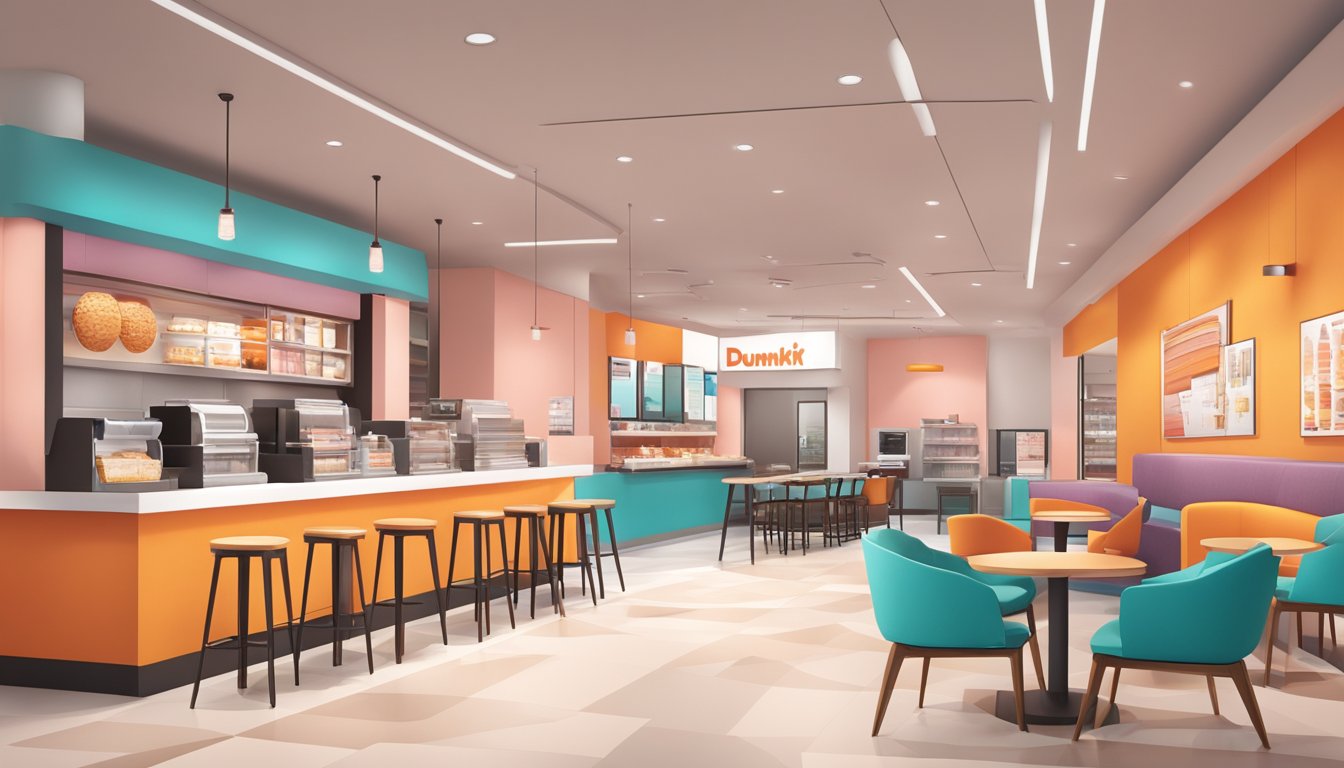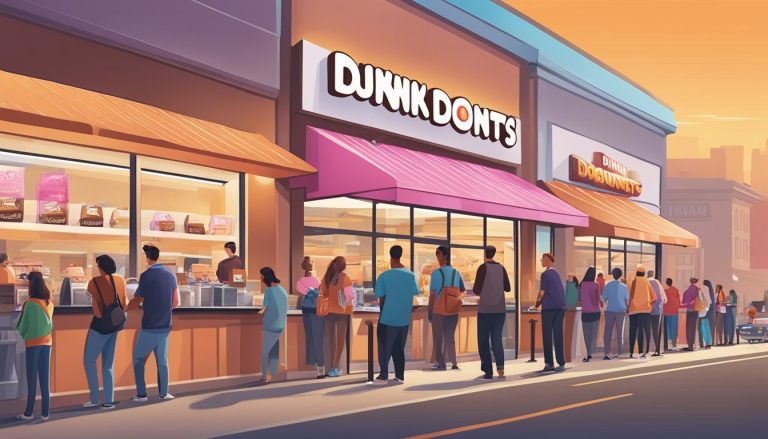Dunkin’ has undergone a remarkable transformation in its store design and atmosphere over the years. The iconic coffee and donut chain has evolved from a simple morning destination to an all-day beverage and food stop. Dunkin’s redesigned stores now feature a modern, inviting ambiance with clean lines, vibrant colors, and well-defined brand elements that reflect its updated identity.
The rebranding effort included simplifying the logo by removing “Donuts” and retaining the familiar pink and orange color scheme. This change signaled Dunkin’s shift towards a broader menu offering while maintaining its core identity. The company’s store redesigns have played a crucial role in supporting its global expansion efforts, allowing Dunkin’ to adapt to local tastes in countries across Asia, Europe, and the Middle East.
Dunkin’s updated store design incorporates contemporary furniture, improved lighting, and strategic use of its signature colors throughout the space. These changes create a more welcoming environment for customers to enjoy Dunkin’s products throughout the day. The refreshed atmosphere aligns with the brand’s evolution and supports its position as a modern, versatile quick-service restaurant chain.
Historical Overview of Dunkin’s Store Design
Dunkin’s store design has undergone significant transformations since the company’s inception. These changes reflect evolving consumer preferences and the brand’s expansion strategy.
Early Beginnings and Expansion
Dunkin’ Donuts opened its first store in 1950 in Quincy, Massachusetts. The original shops featured simple counters and stools, focusing on quick service. As the brand grew, it maintained a no-frills approach to store design.
In the 1970s, Dunkin’ began its international expansion. The first overseas store opened in Japan, adapting to local tastes while keeping core offerings intact.
Design Transformations Through the Decades
The 1980s and 1990s saw Dunkin’ stores adopt a more uniform look. Orange and pink became signature colors, creating a recognizable brand identity. Seating areas expanded, encouraging customers to linger.
In the early 2000s, Dunkin’ introduced drive-thru windows to many locations. This change catered to on-the-go customers and boosted sales.
The Move Towards Modernization
Recent years have seen Dunkin’ embrace a sleeker, more modern aesthetic. The 2018 rebrand to simply “Dunkin'” reflected this shift. New store designs feature digital menu boards and mobile order pick-up areas.
Dunkin’s “Next Generation” store concept debuted in 2018. These locations boast tap systems for cold beverages, reducing waste and improving efficiency.
Today’s Dunkin’ stores emphasize convenience and technology. Many feature comfortable seating areas and Wi-Fi, appealing to a diverse customer base.
Evolution of Brand Identity and Logo
Dunkin’s visual identity has undergone significant transformations since its inception. The company’s logo and branding have evolved to reflect changing consumer preferences and market trends.
The Significance of Dunkin’s Visual Elements
Dunkin’s iconic color scheme of orange and pink was introduced in the 1970s. This distinctive palette helped the brand stand out from competitors and has become synonymous with Dunkin’s identity. The logo transitioned from a basic text design to a more modern, stylized version in 1976.
The coffee cup symbol, once a prominent feature, was gradually phased out. Dunkin’ refined its logo over time, focusing on a clean, text-based design. These changes aimed to create a more versatile and recognizable brand image across various marketing channels.
Implementing The Name Change and Its Implications
In 2019, Dunkin’ made a bold move by dropping “Donuts” from its name. This change reflected the company’s expanded menu offerings beyond donuts. The simplified “Dunkin'” logo maintained the brand’s familiar font and colors.
The rebranding effort aimed to position Dunkin’ as a beverage-led, on-the-go brand. It emphasized the company’s coffee and beverage options while still acknowledging its donut heritage. This shift allowed Dunkin’ to compete more effectively in the broader quick-service restaurant market.
The name change also facilitated international expansion, as the shortened name was more adaptable to different cultures and languages.
The Redefinition of In-store Experience

Dunkin’ has transformed its store design to create a modern, inviting atmosphere focused on convenience and efficiency. The revamped spaces incorporate open layouts, natural light, and digital technology to enhance the customer experience.
Open Layout and Natural Light
Dunkin’s new store design embraces openness and brightness. Large windows allow ample natural light to flood the space, creating a welcoming environment. The open floor plan improves traffic flow and reduces congestion during peak hours.
Seating areas feature a mix of comfortable chairs, tables, and booths to accommodate various customer preferences. The layout encourages both quick visits and longer stays for those who wish to work or socialize.
Lighter colored materials and finishes contribute to the airy feel. Wood accents add warmth, while pops of Dunkin’s signature pink and orange maintain brand identity throughout the space.
Incorporation of Digital Technology
Digital technologies play a key role in Dunkin’s store redesign. Self-service kiosks allow customers to place orders quickly and customize their drinks without waiting in line. These kiosks reduce wait times and improve order accuracy.
Digital menu boards display offerings clearly and can be updated instantly to reflect new products or promotions. The dynamic displays catch customers’ attention and streamline the decision-making process.
Mobile ordering and payment options integrate seamlessly with in-store operations. Dedicated pickup areas for mobile orders ensure a smooth experience for customers who prefer to order ahead.
Enhancing the Customer Experience
Dunkin’s redesigned stores prioritize speed and convenience without sacrificing quality. The new layout places emphasis on the beverage preparation area, showcasing the brand’s focus on coffee and other drinks.
Improved workspace design allows staff to move efficiently and prepare orders faster. This optimization reduces customer wait times and increases overall satisfaction.
The modernized atmosphere appeals to a broader demographic, attracting younger consumers while maintaining loyalty among long-time patrons. Comfortable seating areas encourage customers to linger, potentially increasing purchases and fostering a sense of community.
Menu Innovations and Offerings

Dunkin’ has undergone a significant transformation in its menu offerings, evolving from a donut-centric brand to a beverage-led powerhouse. This shift has been accompanied by an expansion into breakfast items and beyond, catering to changing consumer preferences.
From Donuts to a Beverage-Led Brand
Dunkin’ started as a donut shop but has strategically pivoted to emphasize its beverage offerings. Coffee now takes center stage, with a wide range of hot and iced options available. The brand has introduced flavored coffees, espresso-based drinks, and cold brew to appeal to diverse tastes.
Smoothies, teas, and other non-coffee beverages have also been added to the menu. This shift reflects Dunkin’s response to growing competition in the coffee market and changing consumer habits.
Expansion into Breakfast and Beyond
Dunkin’ has significantly expanded its food menu beyond donuts. Breakfast sandwiches have become a key focus, with options like bacon, egg, and cheese on various bread choices. The brand has also introduced wraps and biscuit-based items to diversify its morning offerings.
Healthier options, including oatmeal and fruit cups, cater to health-conscious customers. Dunkin’ continues to innovate with limited-time offerings and seasonal specials to keep the menu fresh and exciting.
The brand’s menu evolution demonstrates its adaptability to market trends and customer demands, solidifying its position as a quick-service leader in both beverages and food.
Loyalty Programs and Customer Engagement
Dunkin’ has implemented strategic initiatives to foster customer loyalty and drive engagement. These efforts center around rewards programs, mobile technology, and social media outreach.
Introduction of DD Perks Rewards Program
Dunkin’ launched the DD Perks Rewards Program to incentivize repeat customers. Members earn 5 points for every $1 spent. Upon reaching 200 points, they receive a free beverage.
This program has attracted over 13 million members. It contributes significantly to Dunkin’s revenue, highlighting its effectiveness in driving sales and loyalty.
The rewards structure offers a 6.7% discount when redeeming points for a free iced coffee. This aligns with industry standards for loyalty program benefits.
Leveraging Mobile Ordering and Social Media
Dunkin’ has embraced mobile technology to enhance customer convenience. Their app allows for easy ordering and payment, reducing wait times in stores.
The company maintains an active social media presence across platforms like Facebook, Instagram, and Twitter. They use these channels to promote products, share promotions, and engage directly with customers.
Social media campaigns often feature user-generated content, encouraging customers to share their Dunkin’ experiences online.
Fostering Customer Loyalty through Strategic Engagement
Dunkin’ regularly introduces limited-time offers and seasonal products to keep customers excited and engaged. These promotions are heavily marketed through their digital channels.
The company also personalizes offers based on customer preferences and purchase history. This tailored approach helps increase the relevance of promotions to individual customers.
Dunkin’ has implemented gamification elements in their loyalty program, such as bonus point events and challenges. These features add an element of fun and encourage more frequent visits.
Reimagining Franchising and Store Operations
Dunkin’ has transformed its franchise model and store operations to meet evolving consumer needs. The company has embraced innovative concepts and sustainability initiatives to enhance the customer experience and streamline operations.
Adapting to the Franchise Model
Dunkin’ has refined its franchise approach to ensure consistency across locations while allowing for local market adaptations. The company provides comprehensive training and support to franchisees, equipping them with the tools to succeed in their specific markets.
Franchisees benefit from Dunkin’s established brand recognition and proven business model. This system allows for rapid expansion into new territories while maintaining quality standards.
The franchise model also incorporates flexibility for co-branding opportunities. Some locations feature Dunkin’ alongside Baskin-Robbins, offering a wider range of products to customers.
Next Generation Concept Store and Sustainability
Dunkin’ introduced its Next Generation concept store in 2018, revolutionizing the brand’s physical presence. These stores feature modern designs with open layouts, digital kiosks, and dedicated mobile order pick-up areas.
Energy efficiency is a key focus of the new store design. LED lighting, high-efficiency equipment, and water reduction technologies are standard features.
The DD Green Achievement program underscores Dunkin’s commitment to sustainability. This initiative sets guidelines for constructing and operating more eco-friendly restaurants.
Next Gen stores also incorporate new technology to improve order accuracy and speed of service. Digital menu boards and state-of-the-art brewing equipment enhance the overall customer experience.
Marketing and Strategic Partnerships
Dunkin’ has leveraged innovative marketing approaches and strategic partnerships to strengthen its brand presence and connect with customers. These initiatives have played a crucial role in shaping the company’s image and expanding its reach.
Collaborative Ventures and Co-Branding
Dunkin’ has forged strategic alliances with complementary brands to enhance its offerings and attract new customers. The partnership with Baskin-Robbins stands out as a prime example. This collaboration allows Dunkin’ to offer ice cream flavors in select locations, broadening its product range and appealing to a wider audience.
The brand has also engaged in co-branding efforts with popular consumer goods companies. These partnerships have resulted in limited-edition products and merchandise, generating buzz and driving customer engagement. Dunkin’ has collaborated with lifestyle brands to create themed apparel and accessories, tapping into the trend of brand loyalty as a form of self-expression.
Localized Marketing Campaigns and Community Engagement
Dunkin’ has implemented targeted marketing strategies tailored to specific regions and communities. These campaigns often highlight local flavors, customs, and events, fostering a sense of connection with customers in different areas.
The brand actively participates in community initiatives and sponsorships. This includes supporting local sports teams, schools, and charitable organizations. Such involvement helps Dunkin’ establish itself as a caring corporate citizen and strengthens its ties with local communities.
Dunkin’ utilizes social media platforms to engage with customers on a more personal level. The brand’s presence on TikTok has been particularly successful, featuring collaborations with influencers and employee ambassadors. These efforts have helped Dunkin’ connect with younger demographics and maintain relevance in the digital age.
Looking Ahead: Dunkin’s Future in the QSR Industry

Dunkin’ is poised for continued growth and innovation in the quick-service restaurant (QSR) industry. The company’s focus on beverage sales, digital initiatives, and adapting to changing consumer preferences positions it well for future success.
Continuing Innovation and Growth Trajectory
Dunkin’ plans to expand its presence in new markets, particularly in California. This move will help the brand establish a stronger foothold across the United States. The company’s emphasis on beverage sales is expected to drive growth, with ready-to-drink bottled iced coffee and K-Cups showing strong performance.
Dunkin’s loyalty program, DD Perks, has seen significant membership growth. This trend is likely to continue as the company leverages data to enhance personalized marketing efforts and improve customer experiences.
Mobile ordering, a feature available to rewards members, is anticipated to gain more traction. This convenience-focused approach aligns with modern consumer expectations and supports Dunkin’s overall digital strategy.
Adjusting to Consumer Trends and Market Dynamics
Dunkin’ is adapting its store designs to meet evolving consumer preferences. The company’s “restaurant-of-the-future” concept aims to create more efficient and appealing spaces for customers.
Digital marketing is becoming increasingly important for Dunkin’. The brand is exploring AI-powered solutions to deliver hyper-localized marketing messages, tailoring promotions to specific locations and demographics.
As health consciousness grows among consumers, Dunkin’ may expand its menu offerings to include more nutritious options. This could involve introducing new beverages or food items that cater to health-focused customers.
Dunkin’ is likely to continue investing in its consumer packaged goods (CPG) business. With retail sales of Dunkin’ and Baskin-Robbins products already showing strong performance, this segment presents opportunities for further growth and brand extension.




